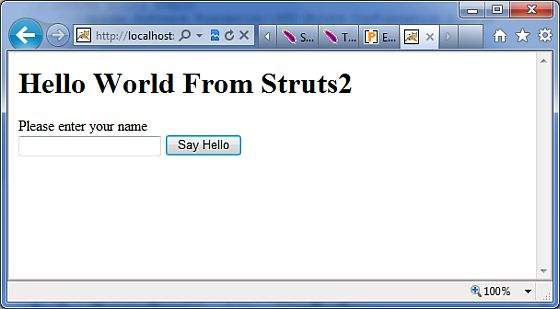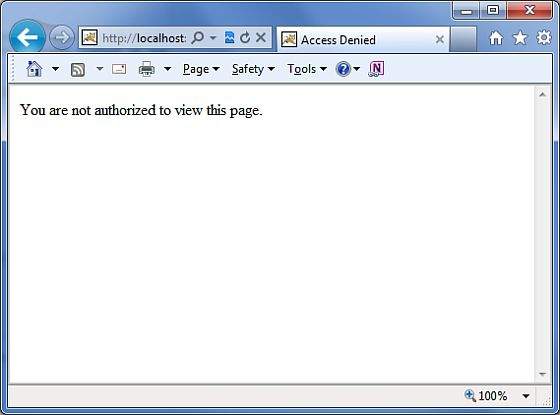public interface Action {
public static final String SUCCESS = "success";
public static final String NONE = "none";
public static final String ERROR = "error";
public static final String INPUT = "input";
public static final String LOGIN = "login";
public String execute() throws Exception;
}
让我们来看看在Hello World示例中的action方法:
package cn.Vue5教程.struts2;
public class HelloWorldAction{
private String name;
public String execute() throws Exception {
return "success";
}
public String getName() {
return name;
}
public void setName(String name) {
this.name = name;
}
}
为了说明action方法控制视图的要点,让我们对execute方法进行以下更改,并扩展ActionSupport类如下:
package cn.Vue5教程.struts2;
import com.opensymphony.xwork2.ActionSupport;
public class HelloWorldAction extends ActionSupport{
private String name;
public String execute() throws Exception {
if ("SECRET".equals(name))
{
return SUCCESS;
}else{
return ERROR;
}
}
public String getName() {
return name;
}
public void setName(String name) {
this.name = name;
}
}
在这个例子中,我们在execute方法中使用一些逻辑来查看name属性。如果属性等于字符串“SECRET”,我们返回SUCCESS作为结果,否则我们返回ERROR作为结果。因为我们已经扩展了ActionSupport,所以我们可以使用String常量、SUCCESS和ERROR。 现在,让我们修改struts.xml文件如下:
<?xml version="1.0" encoding="UTF-8"?>
<!DOCTYPE struts PUBLIC
"-//Apache Software Foundation//DTD Struts Configuration 2.0//EN"
"http://struts.apache.org/dtds/struts-2.0.dtd">
<struts>
<constant name="struts.devMode" value="true" />
<package name="helloworld" extends="struts-default">
<action name="hello"
class="cn.Vue5教程.struts2.HelloWorldAction"
method="execute">
<result name="success">/HelloWorld.jsp</result>
<result name="error">/AccessDenied.jsp</result>
</action>
</package>
</struts>
让我们在你的eclipse项目的WebContent文件夹中创建下面的jsp文件HelloWorld.jsp。右键单击项目资源管理器中的WebContent文件夹,然后选择“New”> “JSP File”。如果返回结果是SUCCESS将调用此文件(这个字符串常量“success”是在Action接口中定义的):
<%@ page contentType="text/html; charset=UTF-8" %> <%@ taglib prefix="s" uri="/struts-tags" %> <html> <head> <title>Hello World</title> </head> <body> Hello World, <s:property value="name"/> </body> </html>
如果action的结果是ERROR,即字符串常量为“error”,下面的文件将被框架调用。 以下是AccessDenied.jsp的内容:
<%@ page contentType="text/html; charset=UTF-8" %> <%@ taglib prefix="s" uri="/struts-tags" %> <html> <head> <title>Access Denied</title> </head> <body> You are not authorized to view this page. </body> </html>
我们还需要在WebContent文件夹中创建index.jsp文件。此文件将用作初始的action URL,用户可以单击它以命令Struts 2框架调用HelloWorldAction类的execute方法并呈现HelloWorld.jsp视图。
<%@ page language="java" contentType="text/html; charset=ISO-8859-1"
pageEncoding="ISO-8859-1"%>
<%@ taglib prefix="s" uri="/struts-tags"%>
<!DOCTYPE html PUBLIC "-//W3C//DTD HTML 4.01 Transitional//EN"
"http://www.w3.org/TR/html4/loose.dtd">
<html>
<head>
<title>Hello World</title>
</head>
<body>
<h1>Hello World From Struts2</h1>
<form action="hello">
<label for="name">Please enter your name</label><br/>
<input type="text" name="name"/>
<input type="submit" value="Say Hello"/>
</form>
</body>
</html>
这样,没有改变web.xml文件的需求,所以我们可以使用前面在Hello World示例章节中创建的的web.xml文件。现在,我们准备好使用Struts 2框架运行我们的Hello World应用程序了。
右键单击项目名称,然后单击“Export”>“WAR File”创建WAR文件。 然后在Tomcat的webapps目录中部署这个WAR文件。最后,启动Tomcat服务器并尝试访问URL http://localhost:8080/HelloWorldStruts2/index.jsp。显示的图示如下:

让我们输入一个单词为“SECRET”,你会看到如下页面:

现在输入除“SECRET”之外的任何词,你会看到如下页面:

你会需要频繁定义多个action来处理不同的请求,并为用户提供不同的URL,因此你将如下定义的不同类:
package cn.Vue5教程.struts2;
import com.opensymphony.xwork2.ActionSupport;
class MyAction extends ActionSupport{
public static String GOOD = SUCCESS;
public static String BAD = ERROR;
}
public class HelloWorld extends ActionSupport{
...
public String execute()
{
if ("SECRET".equals(name)) return MyAction.GOOD;
return MyAction.BAD;
}
...
}
public class SomeOtherClass extends ActionSupport{
...
public String execute()
{
return MyAction.GOOD;
}
...
}
你将如下在struts.xml文件中的配置这些action:
<?xml version="1.0" encoding="UTF-8"?>
<!DOCTYPE struts PUBLIC
"-//Apache Software Foundation//DTD Struts Configuration 2.0//EN"
"http://struts.apache.org/dtds/struts-2.0.dtd">
struts>
<constant name="struts.devMode" value="true" />
<package name="helloworld" extends="struts-default">
<action name="hello"
class="cn.Vue5教程.struts2.HelloWorld"
method="execute">
<result name="success">/HelloWorld.jsp</result>
<result name="error">/AccessDenied.jsp</result>
</action>
<action name="something"
class="cn.Vue5教程.struts2.SomeOtherClass"
method="execute">
<result name="success">/Something.jsp</result>
<result name="error">/AccessDenied.jsp</result>
</action>
</package>
</struts>
正如你在上面的例子中看到的,action的结果SUCCESS和ERROR是重复的。为了解决这个问题,建议您创建一个包含结果的类。